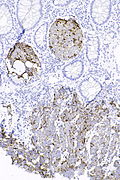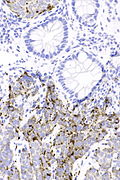Difference between revisions of "Prostatic specific acid phosphatase"
Jump to navigation
Jump to search
| Line 1: | Line 1: | ||
'''Prostatic specific acid phosphatase''', abbreviated '''PSAP''', is [[prostate gland|prostate]] marker that predated [[prostate specific antigen | '''Prostatic specific acid phosphatase''', abbreviated '''PSAP''', is [[prostate gland|prostate]] marker that predated [[prostate-specific antigen]] (PSA). | ||
It is also known as '''prostatic acid phosphatase''', abbreviated '''PAP'''. | It is also known as '''prostatic acid phosphatase''', abbreviated '''PAP'''. | ||
Revision as of 02:19, 18 January 2016
Prostatic specific acid phosphatase, abbreviated PSAP, is prostate marker that predated prostate-specific antigen (PSA).
It is also known as prostatic acid phosphatase, abbreviated PAP.
General
- Cannot differentiate between benign prostate and prostate cancer, like PSA.[1]
Positive
- Benign prostate.
- Prostate cancer.
- Some hindgut neuroendocrine tumours.[2]
Microscopic
Features:
- Cytoplasmic staining.
Images
References
- ↑ Sauvageot, J.; Epstein, JI. (Jan 1998). "Immunoreactivity for prostate-specific antigen and prostatic acid phosphatase in adenocarcinoma of the prostate: relation to progression following radical prostatectomy.". Prostate 34 (1): 29-33. PMID 9428385.
- ↑ Azumi, N.; Traweek, ST.; Battifora, H. (Aug 1991). "Prostatic acid phosphatase in carcinoid tumors. Immunohistochemical and immunoblot studies.". Am J Surg Pathol 15 (8): 785-90. PMID 1712549.

